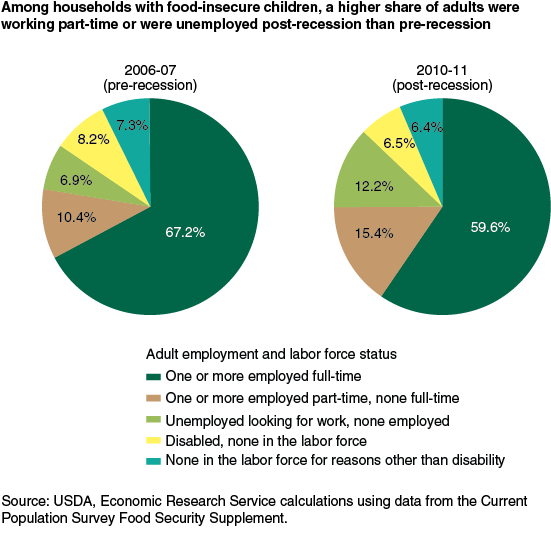Post-Recession, a Greater Share of Food-Insecure Children Have Parents Who Are Unemployed or Working Part-Time
- by Alisha Coleman-Jensen and Mark Nord
- 8/5/2013
Between 2007 and 2011, the percentage of U.S. households with food-insecure children increased from 8.3 to 10.0 percent. Households with food insecurity among children are those in which one or more children lack consistent access to adequate food because the household has insufficient money and other resources for food.
A recent ERS report analyzed the prevalence of food insecurity among children by a variety of household characteristics in 2010 and 2011, updating a previous report based on 2006 and 2007 data (2 years of data were averaged for each analysis). From 2006-07 to 2010-11 (pre-recession to post-recession), the prevalence of food insecurity among children increased in most types of households analyzed, and the characteristics of households with food-insecure children changed somewhat over the period. For example, a somewhat larger portion of households with food-insecure children included an adult with a 4-year college degree in 2010-11 (14.6 percent) than in 2006-07 (10.2 percent).
A key predictor of food insecurity is employment. Among all U.S. households with children, food insecurity rates for children are lowest in households with an adult member employed full-time. In 2010-11, 7.1 percent of households with children that had an adult working full-time had food-insecure children. The prevalence of food-insecure children was higher in households with an adult working only part-time (21.4 percent), in households with an adult unemployed and looking for work and no other adults employed (25.5 percent), and in households with an adult unable to work due to disability and no other adults employed or looking for work (29.4 percent).
Among U.S. households that had food-insecure children, households with unemployed adults and part-time workers comprised a larger portion of the total in the post-recessionary period than in the pre-recessionary period. In 2006-07, 6.9 percent of households with food-insecure children had an adult who was unemployed and looking for work and no other adults employed. By 2010-11, that share had increased to 12.2 percent. In 2006-07, 10.4 percent of households with food-insecure children had an adult working part-time and no adults employed full-time. By 2010-11, that percentage increased to 15.4 percent.
In both periods, the majority of households with food-insecure children included an adult working full-time. However, that percentage declined from 67.2 percent in 2006-07 to 59.6 percent in 2010-11.
These findings emphasize the importance of employment for adult household members in reducing children’s food insecurity. Full-time job opportunities, the availability of employer-provided benefits, and support for households with disabled adults all contribute to reducing food insecurity among children.
This article is drawn from:
- Coleman-Jensen, A., McFall, W. & Nord, M. (2013). Food Insecurity in Households With Children: Prevalence, Severity, and Household Characteristics, 2010-11. U.S. Department of Agriculture, Economic Research Service. EIB-113.
- Coleman-Jensen, A., McFall, W. & Nord, M. (2013). Food Insecurity in Households With Children: Prevalence, Severity, and Household Characteristics, 2010-11. U.S. Department of Agriculture, Economic Research Service. EIB-113.
You may also like:
- Food Security in the U.S.. (n.d.). U.S. Department of Agriculture, Economic Research Service.


